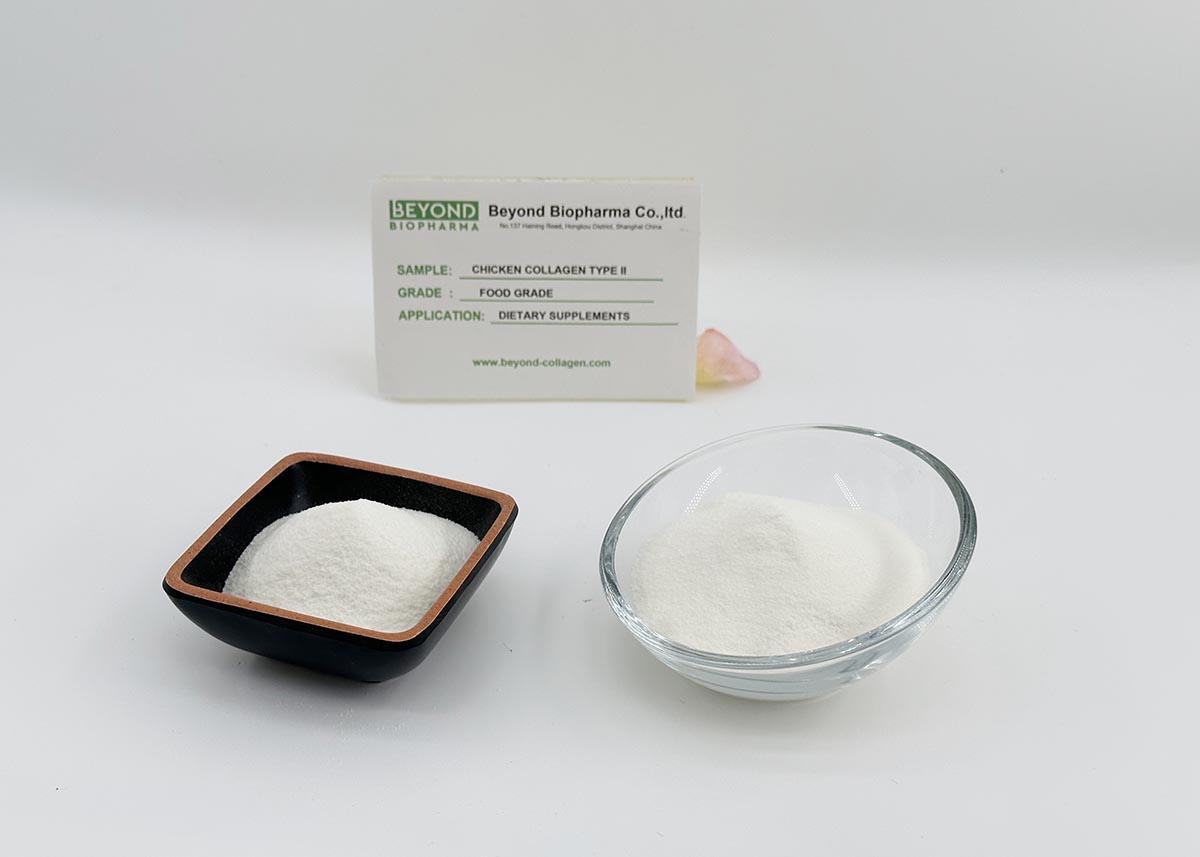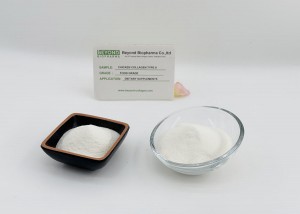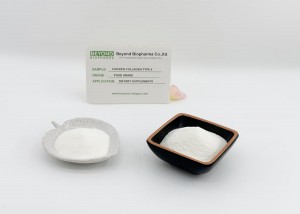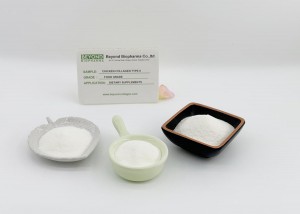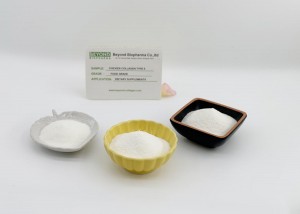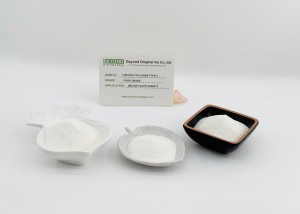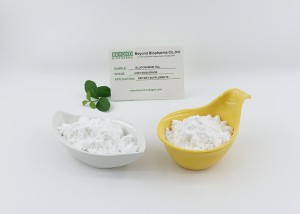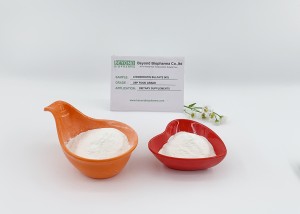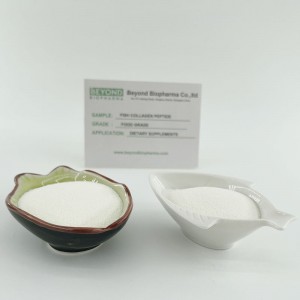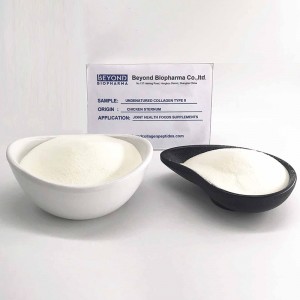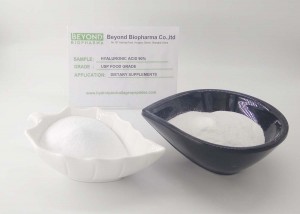Good solubility Undenateured Chicken Type II Collagen Peptide is Good for Joint Repair
| Material name | Undenatured Chicken Collagen type ii for Joint Health |
| Origin of material | Chicken sternum |
| Appearance | White to slight yellow powder |
| Production process | Low temperature hydrolyzed process |
| Undenatured type ii collagen | >10% |
| Total protein content | 60% (Kjeldahl method) |
| Moisture content | ≤10% (105°for 4 hours) |
| Bulk density | >0.5g/ml as bulk density |
| Solubility | Good solubility into water |
| Application | To produce Joint care supplements |
| Shelf Life | 2 years from production date |
| Packing | Inner packing: Sealed PE bags |
| Outer packing: 25kg/Drum |
Collagen is a protein. It provides our bodies with the structure, strength, and flexibility needed for daily life. It enables us to travel, move freely, jump or fall without hurting ourselves. It protects and connects our body parts, so we don't fall apart. Collagen is the most important and most abundant protein in our body.
Collagen peptides are short amino acid chains extracted from natural (full-length) collagen by enzymatic hydrolysis (also known as enzymatic hydrolysis). Collagen polypeptides are bioactive. This means that once they are absorbed into the blood, they can affect the activity of cells in the body in many ways.Collagen peptides, for example, can stimulate fibroblasts in the skin to produce more hyaluronic acid, which is necessary for skin hydration. Biologically active collagen peptides can help the body repair damaged tissues. It can provide structural support for the skin, helps to keep the hair healthy, and helps to maintain bone mineral density.
In short, collagen and collagen peptides are an indispensable part of our human body, and they are also very common in our daily life.
Collagen (collagen) is the most abundant class of protein in mammals, accounting for 25%~30% of the total protein, widely present in the body surface of lower vertebrates to all tissues of the mammalian body. Twenty-seven different types of collagen have been found, with the most common type being type I, type II, and type III collagen. Here are some common collagen types and their main functions:
1. Type I collagen: it is widely found in the skin, bones, teeth, eyes, tendons, viscera and other tissues.
2. Type II collagen: it mainly exists in cartilage, eyeball vitreous body, intervertebral disc, ear and other places.
3. Type III collagen: present in the skin, blood vessel wall, ligaments, muscles, uterus, embryonic tissues, etc.
4. Type IV collagen: mainly distributed in the basement membrane, such as the glomerular basement membrane, and the internal elastic membrane that provides support for blood vessels.
5. Type V collagen: it mainly exists in hair, collagen fiber, liver, alveoli, umbilical cord, placenta, etc.
These collagens play important roles in maintaining the structure and function of various tissues in mammals. Note that not all of the collagen types listed above, and there are other types of collagen also present in mammals.
| PARAMETER | SPECIFICATIONS |
| Appearance | White to off white powder |
| Total Protein Content | 50%-70% (Kjeldahl Method) |
| Undenatured Collagen type II | ≥10.0% (Elisa Method) |
| Mucopolysaccharide | No less than 10% |
| pH | 5.5-7.5 (EP 2.2.3) |
| Residual on Ignition | ≤10%(EP 2.4.14 ) |
| Loss on drying | ≤10.0% (EP2.2.32) |
| Heavy Metal | < 20 PPM(EP2.4.8) |
| Lead | <1.0mg/kg( EP2.4.8) |
| Mercury | <0.1mg/kg( EP2.4.8) |
| Cadmium | <1.0mg/kg( EP2.4.8) |
| Arsenic | <0.1mg/kg( EP2.4.8) |
| Total Bacteria Count | <1000cfu/g(EP.2.2.13) |
| Yeast & Mold | <100cfu/g(EP.2.2.12) |
| E.Coli | Absence/g (EP.2.2.13) |
| Salmonella | Absence/25g (EP.2.2.13) |
| Staphylococcus aureus | Absence/g (EP.2.2.13) |
Unmodified chicken type II collagen is a special collagen type derived from the chicken sternum tissue. This collagen has a unique three-stranded helical structure, which is one of its most remarkable features. This structure is mainly found in the connective tissues and has the role of supporting and connecting the tissues. It is one of the major components of the extracellular matrix and plays an important role in maintaining the tissue structural integrity and function.
An important function of nondegenerative dimorphic collagen is to promote cartilage repair and inhibit cartilage degradation. This is of great significance for maintaining joint health, and for the prevention and treatment of joint diseases.
In contrast, most of the two type II collagen in the market belongs to denatured one type II collagen. After the production process of high temperature and hydrolysis, the quaternary structure has been completely destroyed, the average molecular weight is below 10,000 Daltons, and its biological activity has been greatly reduced.
If non-denaturing diII collagen is abnormal, it may lead to stiff or fragile tissue, causing a variety of diseases, such as excessive keratosis of the skin, hair loss, etc. These symptoms may be related to genetics, such as congenital skin laxa.
Overall, non-denaturing dimorphic collagen is a collagen with a unique structure and function, and has an important role in the maintenance of human health, especially joint health.
Undenatured chicken type II collagen (UC-II) is a form of collagen extracted from chicken cartilage that is not denatured (or chemically altered) during processing. UC-II has been studied for its potential health benefits, particularly in relation to joint health and function. Here are some of the applications of UC-II:
1.Joint Health and Osteoarthritis: UC-II is commonly used as a dietary supplement to support joint health and function. It has been studied for its ability to reduce joint pain and stiffness associated with osteoarthritis (OA), a degenerative joint disease. Some studies suggest that UC-II may help slow the progression of OA and improve joint function in people with this condition.
2.Sports Nutrition: UC-II is also popular among athletes and bodybuilders who use it as a dietary supplement to support joint health during intense physical activity. The collagen can help maintain joint flexibility and reduce the risk of joint injuries.
3. Skin Health: Collagen is a key component of skin, and UC-II may have benefits for skin health as well. It can help improve skin elasticity and reduce the appearance of wrinkles and fine lines. Some skincare products may contain UC-II to enhance their anti-aging effects.
4. Bone Health: Collagen is also important for bone health, and UC-II may support bone strength and density. It may be beneficial for individuals with osteoporosis or other bone-related conditions.
Undenatured Type II Chicken Collagen There is no specific regulation of the eating time, you can choose the appropriate time according to their own personal habits and needs. Here are some common tips for this question:
1. On an empty stomach: Some people like to eat it on an empty stomach, because it can accelerate the absorption and use of its nutrients.
2. Before or after meals: You can also choose to eat before or after meals, eating together with the meal, which may help to reduce digestive discomfort and improve the absorption rate.
3. Before bed: Some people like to eat it before bed, thinking it helps repair cells and regenerate cartilage at night.
Packing: Our packing is 25KG/Drum for big commercial orders. For small quantity order, we can do packing like 1KG,5KG, or 10KG, 15KG in a Aluminum foil bags.
Sample Policy: We can provide up to 30 grams free of charge. We usually send the samples via DHL, if you have a DHL account, please kindly share with us.
Price: We will quote the prices based on different specifications and quantities.
Custom Service: We have dedicated sales team to deal with your inquiries. We promise you will sure get a response within 24 hours since you send a inquiry.
